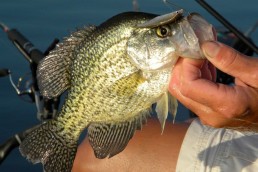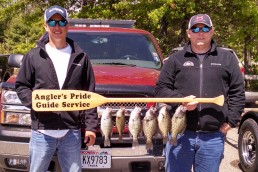Tracking Cold-water Walleyes and Crappies
SHARE THIS POST
Fall starts getting real in October. Some days can be nice in the afternoon, but you can usually plan on it being a little chilly, especially in the mornings.
Most deep lakes in the Ice Belt have their thermocline disappear in September and the lakes usually go through turnover in early October.
Large, shallow lakes or shallow bays of large lakes do not set up a thermocline during the summer because the entire water column gets turned over every time there is a heavy wind.
Deep lakes set up a thermocline during the summer, with the fish wanting to head for deeper water as soon as the thermocline breaks down in September.
Your destination determines if you fish deep or shallow
If walleyes live in a shallow lake, many of the fish move shallow to feed in the fall. Lakes like Winnibigoshish, Leech Lake, Upper Red Lake and Big Traverse Bay of Lake of the Woods are famous for their shallow walleye bites in the fall.
At the same time, Cass Lake, Walker Bay of Leech Lake, Pike’s Bay and many other deep walleye lakes are equally famous for their excellent deep water fall walleye bites.
This means there are walleyes and other fish heading in the opposite direction during the fall, depending on what type of lake or what part of the lake the fish are living.
The cold-water period is by far the longest period of the year for lakes in the Ice Belt. It is also the only part of the year that extends to both open water and hard water, lasting about six months in my part of the country.
Density prevents die-offs
Water is the most dense at 39 point something degrees. Water is least dense when it freezes at 32 degrees. This means the water in the lakes is 39 degrees both before it freezes and below the ice after it freezes.
It’s a good thing, because if water was not most dense at 39 degrees, the lakes would freeze all the way to the bottom during the winter and everything in the lakes would freeze solid and die.
When the very top inch or two of the water columns turns colder than 39 degrees, it begins to float on top of the 39-degree water and eventually freeze and turns to ice.
Perfect time for adventure
October fishing is great for me because my guiding season is winding down and I have more time to do some scouting before the ice-fishing season arrives.
An ideal day for me during October would be grouse hunting in the morning. Then, during the afternoon, I really enjoy cruising around the lakes with my Humminbird Helix 12 with Mega Side-Imaging and looking for interesting spots to check out and mark on my GPS to fish during the long winter months.
Are you enjoying this post?
You can be among the first to get the latest info on where to go, what to use and how to use it!
Targeting the spot on the spot
The cold-water period is all about finding the “spot on the spot.” Fish don’t move around nearly as much during the winter as they do during the summer. Most fish want to be located in an area that supplies all of their needs in a more confined area.
The things I look for depend on what species I am trying to pattern and what type of lake I am fishing (deep or shallow). Different fish like different things. Different lakes offer fish different types of habitat, so lots depends on what is available to the fish.
Walleyes like rocks and gravel bottom, steep breaks into deep water and large, complex food shelves capable of holding enough forage for them to live comfortably most of the winter.
Hunting cold-water walleyes in fall
I usually work backwards when looking for walleyes during the cold-water period. I look for the deep basin areas and then look for anything that touches the deep water, whether it is shoreline or mid-lake structure.
If I am fishing in a shallow lake, I look for shoreline rocks or weeds with a sharp break and “deeper” water nearby. I also look for baitfish.
I get a lot of information from my Humminbird Helix 12 just from what I see on the sonar screen. Sometimes, I still want to see exactly what things look like with my eyes, so I know what species and what size the fish are in the school. I also like to look at the bottom or if there are both crappies and bluegills in the school of panfish. To look things over, I rely on my Aqua-Vu underwater viewing system.
Cracking the crappie code in winter
Crappies are an important species for me during the winter because I guide for them a lot, along with walleyes and perch.
Crappies spend much of the fall and winter in the basin of lakes, but not just in the middle of nowhere. Crappies like isolated open water. This can be between structures, beside structures, on inside turns or points in the basin, or depressions or rises in the basin, or on patches of hard mud or rocks in the basin. Some of the stuff crappies like is hard to describe, but I usually know it when I see it.
Mimic ice rigs for deep crappies
When I find a school of crappies, they are often suspended several feet or more off of the bottom. I like to use a 5-foot ultralight St. Croix Panfish Series Rod, so I can fish close to the boat, where I can see both my lure and the crappies on sonar, much like when I am ice-fishing.
I spool my reel with 3-pound-test Sunline Fluorocarbon and use the Northland PM1 Puppet Minnow with no bait or the 1/32-ounce Buckshot Rattle spoon with a minnow head or wax worm. I also like to use a Dart Minnow with small fathead minnow on the back hook or a small Feather Jig and a minnow with a split shot about two feet above the jig to help get it to the bottom faster.
Remember, crappies will get the “Bends” in water deeper than the mid-20s. So, you may have to keep what you catch, regardless of size.
#Brian Brosdahl Fall Fishing Tips | #Brian Brosdahl Crappie Fishing | #Brian Brosdahl Walleye Fishing | #Fall Walleye Fishing | #Fall Crappie Fishing
MWO
SHARE THIS POST
Did you enjoy this post?
You can be among the first to get the latest info on where to go, what to use and how to use it!
Brian 'Bro' Brosdahl
Outdoor communicator Brian “Bro” Brosdahl lives in northern Minnesota. He is a walleye guide in the Cass Lake, Leech Lake and Lake Winnibigoshish areas. He is sponsored by Northland Fishing Tackle, Frabill/Plano, Aqua-Vu, Humminbird/Minn Kota, St. Croix Rods, Ranger Boats, and Evinrude. Guide inquiries: brosguideservice.com. Follow on social media.


